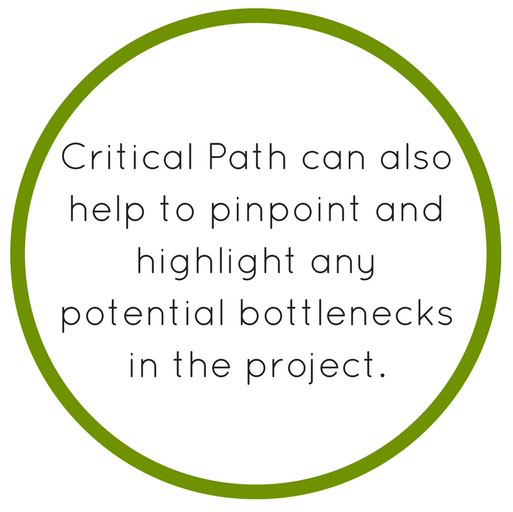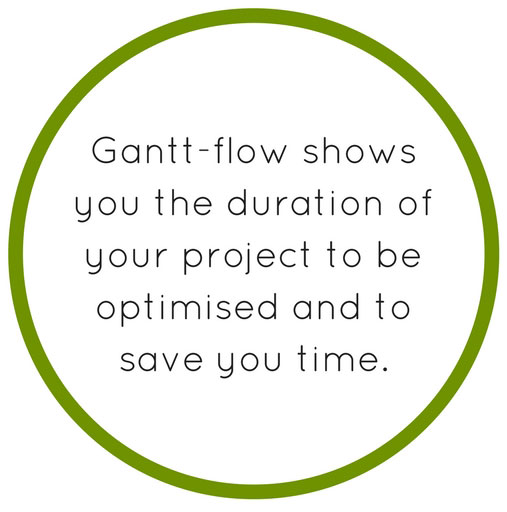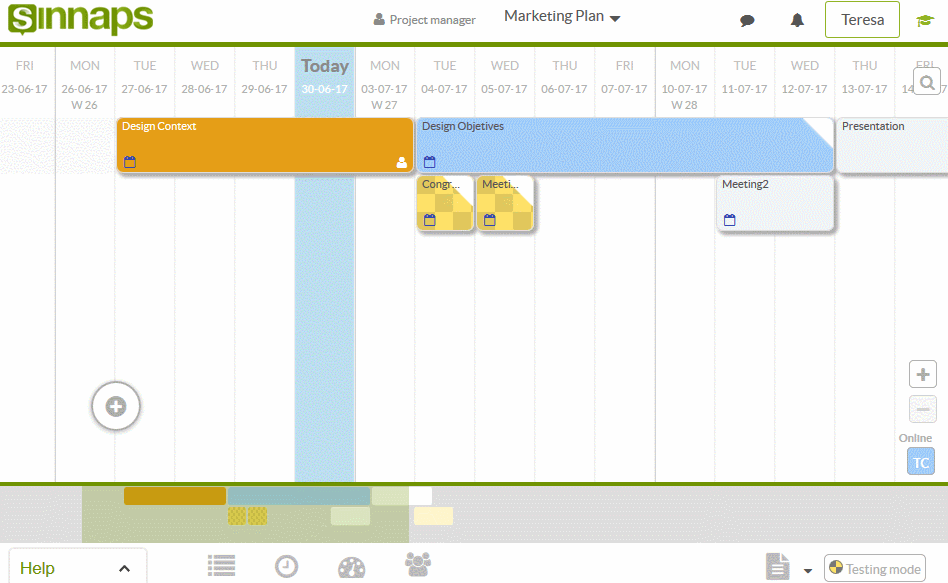The project critical path is comparable to the best route to take on a journey. After gathering all relevant information about your project, you will need to decide on the method of its planning and design, how best to reach your desired destination. With predictive methods the bottlenecks, delivery deadlines of activities and most importantly the project’s critical path will be defined.
In this article, you will learn about what a critical path specifically is and how it is linked to a Gantt chart, you will find the critical path method explained, critical path method questions and answers to be considered during analysis, how the critical path is calculated, and the critical path method diagram. These aspects of CPM are crucial for Project Managers, something that Sinnaps understands and has incorporated into an online app that can effectively show you how the critical path will improve your project progress from here on in.

Índice
Critical Path definition
Some definitions have the critical path method explained in a very complicated way. As stated earlier, the critical path is like the best route to take when on a journey. Essentially, it is the longest sequence of activities within a plan that must be completed on time for the project to be finished successfully and on-time.
Dependencies between activities are crucial in a project’s critical path. Some cannot be started until their predecessor has been completed. This could mean that if any one task is delayed by a day the whole project will be delayed by a day. The basis of critical path analysis and method is combining dependent tasks from start to finish and thus creating a critical path to follow.
This is where the critical path steps in and helps Project Managers and teams in a great way. With the critical path defined, potential bottlenecks can be identified and every stakeholder to the project can see where effort cannot be compromised to get the project done on-time. It is a tool for modelling your project. You input all necessary factors such as tasks, time estimates, task dependencies, milestones or deliverables, any hard deadlines set by clients or stakeholders and get an output of an optimal timeline for completing the project.
Analysing the critical path allows Project Managers to highlight the most important tasks and with this information to allocate resources effectively and to potentially reschedule any lower-priority tasks that may be blocking efficient progress. A critical path basically allows you to see in what way your changes can affect your project before implementing them and therefore not delay results. It is an essential and useful tool in project management and something to which Sinnaps pays great attention within the online scheduling app the presents a Gantt Chart with critical path emphasis.
Gantt Chart and Critical Path
Gantt charts are an effective way to plan your project. It is a means of scheduling the various tasks and activities of your project and tracking their progress against the project’s deadline. A simple Gantt chart can be created on excel, but a much more effective Gantt chart can be created with Sinnaps, incorporating and calculating the critical path which is clearly highlighted and defined to you on the Gantt Chart. It is important to understand that there is a difference between Gantt Chart and critical path analysis.
A Gantt Chart generally consists of a horizontal axis that defines the timespan of your project and a vertical axis which contains the individual tasks. It allows you to monitor you project progress and to set priorities. With Sinnaps colours are used to clearly identify the progress of each specific task, whether it is late, on-time or completed. Everyone involved can easily see what needs to be done and when and an also use a real-time chat to resolve any doubts or make any comments.
The listing of all the activities and tasks relevant to the project is very important and should be done carefully, taking into consideration their potential duration and dependencies. The problem with a simple Gantt Chart is that it does not define task dependencies nor does it demonstrate which tasks are ‘critical’ to completing the project successfully and on-time. Sometimes there is no critical path in Gantt Chart diagrams at all.
This is where CPM (Critical Path Method) plays a key role. The method will allow for a sequence of tasks together with their dependencies and importance to be calculated. It can also help to pinpoint and highlight any potential bottlenecks in the project that could hamper you finishing on time so that you can do something about them. The critical path is essential to an effective Gantt Chart. Sinnaps combines the difference between Gantt chart and critical path analysis to create what is called the Gantt-flow.
The critical route is fundamental to Sinnaps Gantt-flow adaptation of the Gantt Chart. Sinnaps understands that a Gantt chart with critical path inclusion is much more effective and useful to project management. Through technologies such as PERT and CPM which will be explained further on, the critical path of the project is calculated and can be recalculated at any time. Better yet, before actually implementing a recalculated route, the Project Manager can try the proposed modification in Testing or Edit Mode which will allow them to see how the change would impact the project as a whole and then to decide whether to implement it or not.
Sinnaps Gantt-flow adaptation

CPM: Critical Path Method
The critical path method is the technique by which activities in a project are identified on a critical path. The tasks that are critical, in terms of time are clearly identified. By using critical path method scheduling, you are one step closer to completing your project on time. It creates a planned schedule for a team to follow and serves as a benchmark through the comparison of actual against planned performance. The critical path method allows a project team to identify and take into consideration project dependencies, the importance of which is put into perspective by Terence Jackson, Ph.D. and CEO/Managing Partner at WEpiphany LLC:
“Some of the activities must happen in parallel. For example, if you tried to make a fried breakfast by doing one task at a time, and one after the other, things would go wrong. The plates need to be warming while other activities are going on. The toast needs to be toasting while the sausages are frying, and at the same time the bacon and sausages are under the grill. The eggs need to be fried last. A critical path analysis is a diagrammatical representation of what needs to be done and when. Timescales and costs can be applied to each activity and resource.”
 Some of the advantages of critical path method use within Sinnaps’ Gantt-flow include:
Some of the advantages of critical path method use within Sinnaps’ Gantt-flow include:
- The most critical tasks are identified: Tasks that are to be closely managed are identified and allow for the manager and team members to act accordingly with such activities in terms of resource allocation and time. It helps to avoid delays as all involved understand the negative effect of delaying a critical ask on the whole project.
- Time is optimised: After the initial design of the project, a critical path can further aid in duration reduction if the need arises. As a critical path shows which tasks are critical and which are not so much you can decide to reduce the time of some of the not-so critical activities. The importance of critical path method use is clear and with the pairing of a Gantt chart, it is easy to see where the tasks fall in the overall timeframe as well as the sequences and duration of each task. This deeper level of insight into you project will allow for the duration of your project to be optimised and to save you time. This benefit is highlighted in the various advantages of critical path method use for your projects.
- Helps to keep track of progress: The use of the critical path method can be used as an effective comparison tool of your actual and planned/projected progress. During a project, the completed tasks are identified as are the predicted durations of the remaining tasks. Any planned changes to future tasks and their effect on the project can create a visual as to what the project will look like and can serve as a comparison of planned and actual progress.
- Highlighting parents and children: This is linked with task dependencies that a critical path will help to identify and highlight. The ‘children’ are the tasks which are dependent on their ‘parent’ tasks which must be completed for them to begin.
- The project float is identified: The float shows the amount of time by which activities can be delayed with negatively affecting the project’s end-date.
- The criticality of all activities is shown: With Sinnaps’ Gantt flow, not only the tasks on the critical path which optimises the productivity of the project as a whole.
Critical Path Analysis Questions
The work involved in completing the project must be broken down and all activities should be clearly identified and defined. Certain critical path method questions and answers must be asked and answered when analysing the critical path and determining the project’s float. These include:
- What is the earliest time that an activity can start?
- What is the estimated time in completing the activity?
- What is the earliest time the activity can finish?
- What is the latest time an activity can be started without delaying the overall project duration?
- By how much time can the completion of an activity be delayed without delaying the overall project duration?
- What is the latest time an activity can finish without delaying the overall project duration?
A critical path will exist in any project. The importance of critical path method analysis cannot be ignored. The path continuous, but may branch out into an additional parallel path. This additional path is called the sub-critical path. These sub-critical paths are more common in complex projects. Sinnaps online planning tool allows you to view the various critical paths while highlighting a specific characteristic common to all of them.
There are various critical path analysis advantages and disadvantages. One of the disadvantages being that a critical path only reflects the time element, while a compromise in either cost or quality can also have an impact on the project. Through EVM (Earned Value Management) Sinnaps allows for both quality and cost to be taken into consideration. During a project, certain aspects of the critical path can change or will need to be changed. Sinnaps’ Test Mode in which you can also apply EVM, allows Project Managers to try out these changes without implementing them to see the effect.
Sinnaps’ Test Mode

How to calculate critical path?
The critical path in Gantt Chart formations plays a key role. To calculate how long it will take to complete the sequenced work of the project a forward pass must be performed. This done by adding the planned start and duration of the project.
Early Start + Duration = Early Finish
To find the latest dates that an activity can begin, taking into consideration certain fixed date restrictions, without affecting the end date a back pass is performed. The early finish of the last activity in the network is transferred to the late finish.
Late Finish – Duration = Late Start
The flexibility or float can now be worked out in the project. This is important in the sense that it allows for decisions to be made effectively taking resources into account.
There exist two different types of float:
Free Float: This refers to the amount of time a task or activity can be delayed, taking into consideration milestones that must be reached and certain fixed date restrictions, without affecting the next dependent task. Within the critical path method scheduling this is calculated by subtracting the Early Finish of a task from the Early Start of its subsequent activity.
Total Float: This refers to the amount of time which an activity can be delayed without affecting the end date of the project.
Latest Finish – Earliest Finish = Float
With the early start and late start for each activity identified and the available float calculated, the critical path can be identified. It is normally highlighted, as it the case in the Sinnaps Gantt-flow and has zero float available.
Critical Path Method Calculator
Using the critical path method to schedule projects began back in the 1950s when the US Navy’s Fleet Ballistic Missile (Polaris) Program was running behind schedule. Help was needed to resolve the issue. A suggestion was to divide the whole program into various tasks, represent each task in arrow form and connect the arrows in sequence. In this way, the duration of each task can be estimated and in turn the whole project duration can be estimated while also identifying the criticality of each project to getting the project done on time.
Around the same time, an American chemical company was going through delays in a project to rearrange production facilities for different products. For them, the suggestion was very similar to that of the Polaris Program. From the two experiences came two techniques: PERT (Project Evaluation and Review Technique) and CPM (Critical Path Method). Critical path method scheduling helped to optimise and improve both organisations’ projects exponentially. Although the two methods are similar, the use different techniques for estimating the duration of each task. Sinnaps uses both techniques in the online app Gantt-flow.
To calculate the critical path there are several methodologies and techniques, such as PERT and CPM methods, which when combined with a Gantt chart, can easily portray the optimal workflow of the project as seen in the Sinnaps online project management tool. The application of critical path method tools is fundamental to Sinnaps online scheduling app.
The critical path of a project can be obtained automatically if we use the right tools. Sinnaps calculates the critical path of a project by applying a technology based on PERT and CPM techniques, generating a visual plan on a Gantt Chart, which it calls the Gantt-flow. Any deficiencies of a simple Gantt Chart are solved with the help of these tools.
Critical Path Diagram
A Precedence Diagramming Method (PDM), which is sometimes also known as the Activity on Node (AON) Diagramming Method is a critical path method diagram technique which graphically represents the inter-dependencies between various project activities. The method is used to draw the Critical Path Network diagram or the Critical Chain Network Diagram.
In an opposite way to AON Diagramming, AOA (Activity on Arrow), all dependencies are finish to start. PERT is an example of such a method. It is less common than AON and puts more emphasis on milestones while AON/PDM methods put more emphasis on the tasks.
The main benefit of PDM is that it clearly highlights task dependencies and is an important factor in communicating to stakeholders. The Gantt chart is an effective platform where this diagram can be clearly drawn and created. The critical path in Gantt Chart developed transforms it from an average platform to a very useful and important tool in project management.
Companies that are involved in the creation of various innovative and complex project designs understand the importance and competitive advantage that the continuous improvement can bring to their business. The main goal is to be able to create productive projects of which the work routes are fully optimised, with minimum resources that can obtain the best result possible. This is what Sinnaps aims to do for your project with the help of the critical path and Gantt-flow.

Sinnaps allows for your project to be completed in a minimum amount of time through the coordination of teams, the critical path, resources and highlighting bottlenecks. It is an easy to use, interactive and effective online app that calculates and highlights for you your best possible work path based on the activities you add or change in your planning stage.
Overall, it is clear that project management can be quite complex. There is no guarantee that your project will turn out successfully, however there exist tools such as Sinnaps that can exponentially improve and increase your chances of completing your project effectively and efficiently in major part thanks to our friend critical path! Stop wasting time, begin finding the critical path of your project with Sinnaps today!

